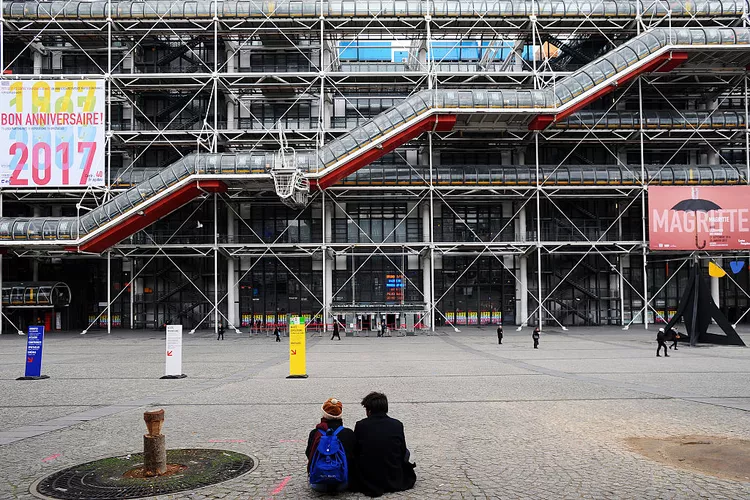1. Overview of the Centre Pompidou
2. History of the Centre Pompidou
3. The National Museum of Modern Art-Centre de Création Industrielle
4. Visiting the Centre Pompidou
5. Eating at the Centre Pompidou
Centre Georges Pompidou: A Cultural Landmark in Paris
Centre Georges Pompidou is one of the great attractions in Paris, serving as a vibrant cultural hub that draws visitors for its architectural innovation, public performances, and eclectic cultural programs. Its modern and progressive design remains a point of interest for many, making it an essential landmark in the heart of the city.
The Centre Georges Pompidou is home to the National Museum of Modern Art, which boasts an impressive collection of 20th century art, and it celebrates various forms of modern and contemporary media, including literature, theater, film, and music. Consequently, it ranks as the fifth most visited attraction in Paris, welcoming approximately 3.8 million visitors each year.
1. Overview of the Centre Pompidou
The Centre’s striking architecture and lively public spaces, often showcasing street performers and local artists, create an inviting atmosphere. This makes it a favorite destination for both locals and tourists looking to immerse themselves in the arts.
2. History of the Centre Pompidou
This beloved cultural center was conceived by President Georges Pompidou, who envisioned a central location dedicated to modern creations back in 1969. Designed by the renowned British architect Richard Rogers and Italian architects Renzo Piano and Gianfranco Franchini, it is known for its distinctive architectural style. The Centre opened its doors on January 31, 1977, introducing revolutionary ideas, cutting-edge design, and advanced technical specifications. Although the concept of moving floors to create adjustable spaces was not realized due to cost and practicality concerns, the design remains iconic.
The initial directors of the museum hosted groundbreaking exhibitions, such as Paris – New York and Vienna: Birth of a Century, which contributed to the Centre’s reputation as an essential cultural site. In 1992, the venue expanded its offerings to include live performances, films, lectures, and debates. A significant renovation occurred between 1997 and 2000, further enhancing the facility.
3. The National Museum of Modern Art-Centre de Création Industrielle
The museum proudly showcases over 100,000 works from the early 20th century to contemporary art. Expanding its original collections from the Muséede Luxembourg and the Jeu de Paume, the museum has included important artists like Giorgio de Chirico, René Magritte, and Jackson Pollock into its acquisitions policy.
Photograph Collection: The Centre Pompidou houses Europe’s largest collection of photographs, featuring around 40,000 prints and 60,000 negatives. This extensive collection includes works from influential artists such as May Ray and Brassaï, highlighting the evolution of photography during the 20th century.
Design Collection: This comprehensive collection features modern designs from notable figures such as Eileen Gray and Philippe Starck, along with exceptional and unique pieces. Many of these works have become iconic representations of their time.
The Cinema Collection: Established in 1976, this collection focuses on experimental films and now includes 1,300 works by visual artists and directors that challenge traditional cinematic norms.
The New Media Collection: As the largest collection of its kind globally, it encompasses multimedia installations and various digital works, featuring prominent artists like Doug Aitken and Mona Hatoum.
The Graphic Collection: Comprising around 20,000 drawings and prints, this remarkable collection includes works from celebrated artists like Marcel Duchamp and Wassily Kandinsky and is enhanced by a policy allowing tax-acquisition art offerings.
4. Visiting the Centre Pompidou
Situated in the bustling Beaubourg neighborhood on Paris’ right bank, the Centre Pompidou offers a multitude of activities and attractions nearby. It is advisable to dedicate at least half a day to fully appreciate the features of the Centre.
Location: Place Georges Pompidou, 4th arrondissement
Contact: Tel: +33 (0)1 44 78 12 33
Opening Hours: Daily, excluding Tuesdays, from 11 AM to 10 PM (exhibitions close at 9 PM); Thursdays open until 11 PM for exhibitions on level 6.
Admission Fees: Adult ticket: €14; Reduced: €11. View of Paris ticket (access to view only, no museum exhibitions) costs €3. Notably, the first Sunday of each month offers free admission.
The Paris Museum Pass also provides free access; it is valid for 60 museums and monuments, available in several durations for various prices.
5. Eating at the Centre Pompidou
Restaurant Georges: Located on level 6, this upscale restaurant is known for its delicious food and striking views of the city. It is open daily from noon to 2 PM.
Mezzanine Café: Located on level 1, this café offers a variety of light snacks and is open daily (excluding Tuesdays) from 11 AM to 9 PM.





